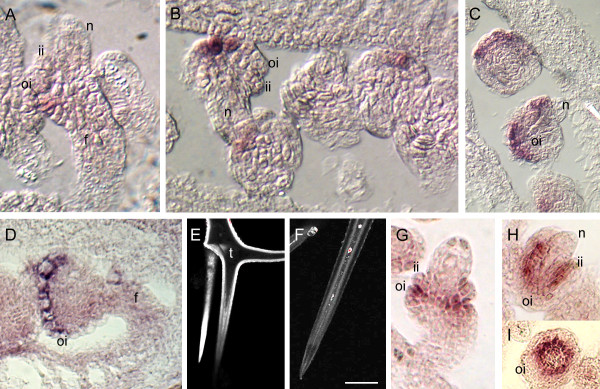Figure 7.
In situ hybridization pattern of At2g34700 and ATS in ovules and sub-cellular localization of At2g34700-GFP protein fusion. (A-D): At2g34700 antisense probe; (E, F): confocal fluorescence micrographs of trichomes; (G – I): ATS antisense probe. Expression of At2g34700 was seen in the basal outer integument at emergence, (A) and was often in only one to two cells in the outer cell layer of the outer integument (B). As the integument grew, expression expanded both basally and apically but was not present in all cells of the outer layer at the same time (C). Close to anthesis, expression was strong and uniform in the outer integument (D). Arabidopsis trichomes stably transformed with a construct constitutively expressing a C terminal GFP fusion protein (P-UBQ10: At2g34700-GFP) showed fluorescence predominantly in the cell wall, indicating secretion of the fusion protein (E). Untransformed wild type trichomes showed low autofluoresence in the cell, mostly at the cell wall-plasma membrane junction (F). Excitation was increased several fold relative to (E) in order to observe the dimmer fluorescence. As the two integuments emerged, ATS expression was seen in the outer (abaxial) layer of the inner integument, and inner (adaxial) layer of the outer integument (G), and became confined to the inner integument as it extended along the nucellus (H). This expression formed a ring corresponding to inner integument encircling the nucellus (I). Scale bar = 30 μm in A, B, D, G, and H; 45 μm in C and I; 25 μm in B and E; 30 μm in E; and 25 μm in F. f, funiculus; n, nucellus; ii, inner integument; oi, outer integument; t, trichome.

